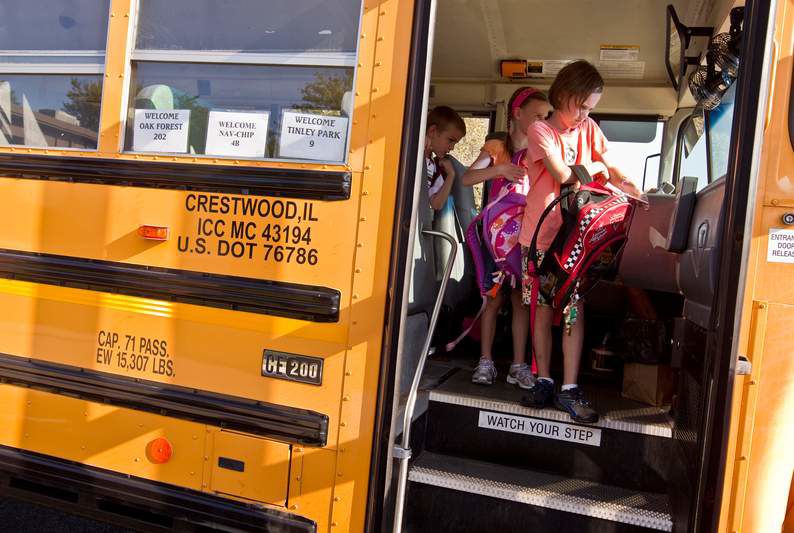School bus GPS system gives parents peace of mind
Published 5:00 am Tuesday, September 14, 2010

- Chippewa Elementary students Ellie and Kate McGovern pass an ID scanner as they exit the school bus at Chippewa Elementary School in Palos Heights, Ill., last month. Students at the school carry tracking cards so officials are able to pinpoint where and when they get on and off school buses.
CHICAGO — Josh Case climbed aboard the yellow school bus recently, lifting his backpack to scan an ID card that had been assigned to him on his first day of kindergarten.
With a quiet beep and a flash of a green light, the 5-year-old was logged into a new system that allows a transportation supervisor sitting miles away to track when and where each student in Palos Heights School District 128 stepped on and off the bus.
“It beeped. I heard his beep,” said Jennifer Case as she gave her youngest son one last kiss before the bus doors closed. “Now, he’s in there. He’s good.”
The southwest suburban Chicago district rolled out the new system this month, becoming the second school district in the state to use technology not only to track school buses, but also the students who ride them, officials said.
It is the newest technological twist in the effort to ease parents’ nerves and keep students safe. Today’s parents, torn between wanting to give their kids more independence while also keeping them from harm, can now send them off knowing they can call the school to make sure their child arrived or to check if the child is late returning from school.
“I felt it was a responsibility on our part to do what we can,” Superintendent Kathleen Casey said Tuesday morning as students filed off buses at Chippewa Elementary School.
Casey researched the technology last year after a first-grade student missed his stop, remaining on the bus as it rolled by his grandmother, who stood waiting for him. Casey said the child never left the bus, but for 20 minutes, school officials and family members raced to find him.
“It’s a terrifying experience,” said Casey. “I wondered if this technology would give us the ability to identify ‘Did a child get on the bus? Did they get off? If they got off, did they get off at the right stop?’ ”
Keeping track
About 5 percent of the 490,000 school buses that transport kids across the country are believed to use the student tracking technology, according to the National Association for Pupil Transportation.
“It’s absolutely growing, and I think exponentially,” said Executive Director Mike Martin.
Palos Heights officials assigned the ID tags to 400 students in preschool through fifth grade. Teachers clipped a card — plain but for a smiley-face sticker — to each student’s book bag.
From her office, Transportation Director Barbara Lynch can check when a student boards or exits a bus or when a bus leaves the school. If a parent calls to inquire about a late student, Lynch or the school secretaries — they are the only ones able to log into the system — can determine the bus’s location along the route and whether a particular child is on board. The system updates every 30 seconds, she said.
The system uses GPS technology to track the buses. Students are logged in to the bus using radio frequency identification. That’s the same technology many workers use to scan ID cards when they enter their workplaces.
The district paid $16,000 for the technology on 10 school buses — a price that included the cards, which cost $3.25 each. Seattle-based Zonar Systems provided the technology.
‘A huge relief’
Educators and family experts say the peace of mind could help parents who surrender control when they send their child onto the school bus, not knowing the bus driver as well as they typically know the teacher or principal.
A relaxed parent can ultimately make for a happier child.
“If technological advances make the parent feel less anxious and more at ease, then I think that can help. Whatever it’s going to take for the parent to feel relaxed, because the child feeds off the parent,” said therapist David Klow with the Family Institute at Northwestern University.
Earlier this month, Palos Heights parent Patty Spacil waited at the bus stop with daughters Matty, 10, and Tess, 7, who both sported the ID cards.
Spacil welcomed the new safety measure.
“It’s a huge relief,” said Spacil. While she walked to school as a child growing up in Chicago, she said, “we don’t have sidewalks here, and it’s just a different time.”
The Case family found a practical use for the tracking system on Monday. Josh’s first day of kindergarten ended at 3 p.m., and 45 minutes later he still wasn’t home. With one quick phone call to the school, Jennifer Case learned that the bus was running a little late.
“We just want to know there is some kind of backup,” Michael Case said. “Did he get on the bus?”






